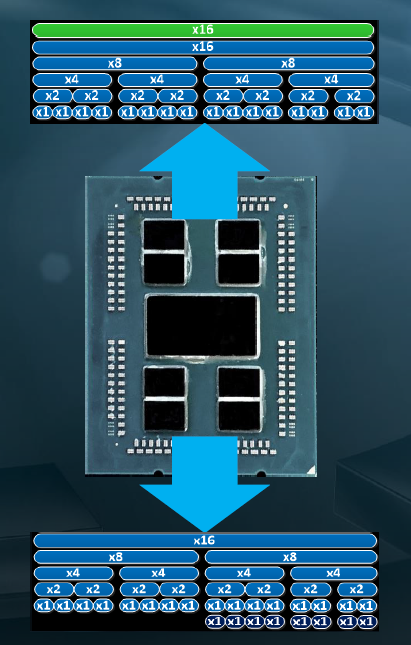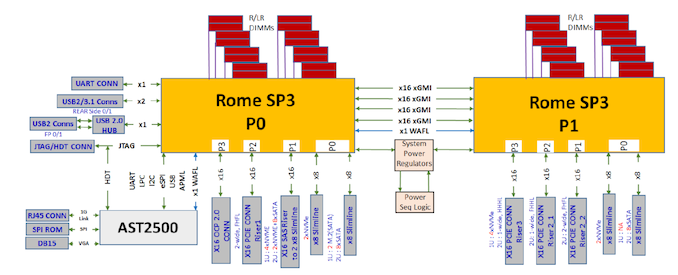AMD Rome Second Generation EPYC Review: 2x 64-core Benchmarked
by Johan De Gelas on August 7, 2019 7:00 PM ESTPCIe 4.0
As the first commerical x86 server CPU supporting PCIe 4.0, the I/O capabilities of second generation EPYC servers are top of the class. One PCIe 4.0 x16 offers up to 32 GB/s in both direction, so each socket offers up to 256 GB/s in both directions, for a full 128 PCIe 4.0 lanes per CPU.
Each CPU has 8 x16 PCIe 4.0 links available which can be split up among up to 8 devices per PCIe root, as shown above. There is also full PCIe peer-to-peer support both within a single socket and across sockets.
With the previous generation, in order to enable a dual socket configuration, 64 PCIe lanes from each CPU were used to link them together. For EPYC, AMD still allows for 64 PCIe lanes to be used, but these are PCIe 4.0 lanes now. There is also another feature that AMD has here - socket-to-socket IF link bandwidth management - which allows OEM partners to design dual-socket systems with less socket-to-socket bandwidth and more PCIe lanes if needed.
We also learned that there are in fact 129 PCIe 4.0 lanes on each CPU. On each CPU there is one extra PCIe lane for the BMC (the chip that controls the server). Considering we are living in the age of AI acceleration, the EPYC 7002 servers will be great as hosts for quite a few GPUs or TPUs. Density has never looked so fun.












180 Comments
View All Comments
sing_electric - Thursday, August 8, 2019 - link
Not just Netburst - remember, Intel's plans were ORIGINALLY for Itanium to migrate down through the stack, ending up in consumer machines. Two massively costly mistakes when it came to planing the future of CPUs. Honestly, I hope Intel properly compensated the team behind the P6, an architecture so good that it was essentially brought back a year after release to after those 2 failures.OTOH, it's kind of amazing that AMD survived the Bulldozer years, since their margin for error is much smaller than Intel's. Good thing they bought ATI, since I'm not sure the company survives without the money they made from graphics cards and consoles...
JohanAnandtech - Thursday, August 8, 2019 - link
Thank you for the kudos and sympathy. It was indeed hot! At 39°C/102°F, the server was off.I agree - I too admire the no-nonsense leadership of Lisa Su. Focus, careful execution and customer centric.
WaltC - Thursday, August 8, 2019 - link
AMD has proven once again that Intel can be beaten, and soundly, too...;) The myth of the indestructible Intel is forever shattered, and Intel's CPU architectures are so old they creak and are riddled with holes, imo. Where would Intel have put us, if there'd been no AMD? You like Rdram, you like Itanium, just for starters? You like paying through the nose? That's where Intel wanted to go in its never-ending quest to monopolize the market! AMD stopped all of that by offering an alternative path the market was happy to take--a path that didn't involve emulators and tossing out your software library just to give Intel a closed bus! Intel licensed AMD's x86-64, among other things--and they flourished when AMD dropped the ball. I chalk all that up to AMD going through a succession of horrible CEOs--people who literally had no clue! Remember the guy who ran AMD for awhile who concluded it made sense for AMD to sell Intel servers...!? Man, I thought AMD was probably done! There's just no substitute for first-class management at the top--Su was the beginning of the AMD renaissance! Finally! As a chip manufacturer, Intel will either learn how to exist in a competitive market or the company over time will simply fade away. I often get the feeling that Intel these days is more interested in the financial services markets than in the computer hardware markets. While Intel was busy milking its older architectures and raking in the dough, AMD was busy becoming a real competitor once again! What a difference the vision at the top, or the lack of it, makes.aryonoco - Thursday, August 8, 2019 - link
That dude was Rory Read, and while the SeaMicro acquisition didn't work out, he did some great work and restructured AMD and in many ways saved the company while dealing with the Bulldozer disaster.Rory stablized the finances of the company by lowering costs over 30%, created the semi-custom division that enabled them to win the contracts for both the Xbox and PS4, creating a stable stream of revenue. Of course Rory's greatest accomplishment was hiring Lisa Su and then grooming her to become the CEO.
Rory was a transitional CEO and he did exactly what was required of him. If there is a CEO that should be blamed for AMD's woes, it's Dirk Meyer.
aryonoco - Thursday, August 8, 2019 - link
Forgot to mention, Rory also hired Kim Keller to design K12, and in effect he started the project that would later on become Zen.Of course Lisa deserves all the glory from then on. She has been an exceptional leader, bringing focus and excelling at execution, things that AMD always traditionally lacked.
tamalero - Sunday, August 11, 2019 - link
Id Blame Hector Ruiz first.It was his crown to lose during the Athlon 64 era, and he simply didn't have anything to show. Making the Athlon 64 core arch a one hit wonder for more than a decade.
MarcusTaz - Wednesday, August 7, 2019 - link
Another site's article that starts with an F stated that Rome runs hot and uses 1.4 volts, above TMSC recommended 1.3 volt. Did you need to run 1.4 volts for these tests?evernessince - Wednesday, August 7, 2019 - link
Well 1st, that 1.3v figure is from TSMC's mobile focused 7nm LPP node. Zen 2 is made on the high performance 7nm node, not the mobile focused LPP. Whatever publication you read didn't do their homework. TSMC has not published information on their high performance node and I think it rather arrogant to give AMD an F based on an assumption. As if AMD engineers are stupid enough to put dangerous voltages through their CPUs that would result in a company sinking lawsuit. It makes zero sense.FYI all AMD 3000 series processors go up to 1.4v stock. Given that these are server processors, they will run hot. After all, more cores = more heat. It's the exact same situation for Intel server processors. The only difference here is that AMD is providing 50 - 100% more performance in the same or less power consumption at 40% less cost.
DigitalFreak - Thursday, August 8, 2019 - link
You reading Fudzilla?Kevin G - Wednesday, August 7, 2019 - link
AMD is back. They have the performance crown again and have decided to lap the competition with what can be described as an embarrassing price/performance comparison to Intel. The only thing they need to do is be able to meet demand.One thing I wish they would have done is added quad socket support. Due to the topology necessary, intersocket bandwidth would be a concern at higher core counts but if you just need lots of memory, those low end 8 core chips would have been fine (think memcache or bulk NVMe storage).
With the topology improvements, I also would have liked AMD to try something creative: a quad chip + low clocked/low voltage Vega 20 in the same package all linked together via Infinity Fabric. That would be something stunning for HPC compute. I do see AMD releasing some GPU in a server socket at some point for this market as things have been aligning in this direction for sometime.
Supporting something like CCIX or OpenCAPI also would have been nice. A nod toward my previous point, even enabling Infinity Fabric to Vega 20 compute cards instead of PCIe 4.0 would have been yet another big step for AMD as that'd permit full coherency between the two chips without additional overhead.
I think it would be foolish to ignore AVX-512 for Zen 3, even if the hardware they run it one continues to use 256 bit wide SIMD units. ISA parity is important even if they don't inherently show much of a performance gain (though considering the clock speed drops seen in Sky Lake-SP, if AMD could support AVX-512 at the clocks they're able to sustain at AVX2 on Zen 2, they might pull off an overall throughput win).
With regards to Intel, they have Cooper Lake due later this year. If Intel was wise, they'd use that as a means to realign their pricing structure and ditch the memory capacity premium. Everything else Intel can do in the short term is flex their strong packaging techniques and push integrated accelerators: on package fabric, FPGA, Optane DIMMs etc. Intel can occupy several lucrative niches in important, growing fields with that they have in-house right now but they need to get them to market and at competitive prices. Otherwise it is AMD's game for the next 12 to 15 months until Ice Lake-SP arrives to bring back the competitive landscape. It isn't even certain that Intel can score a clean win either as Zen 3 based chips may start to arrive in the same time frame.